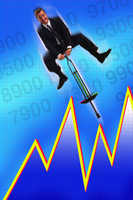| Home | About | Archives | RSS Feed |

@theMarket: Markets Turn Positive for the Year
 |
It is official. We made a new high this week and the markets appeared to be in "melt-up" mode. So why is everyone cautious?
After almost two months of consolidation, the equity markets broke out once again, spurred by the knowledge that if the economy falters, the Fed remains ready to reverse course.
Yet, by Friday afternoon, the bears were fighting hard to ruin the party.
It was no accident, in my opinion, that Fed Chairwoman Janet Yellen's testimony before a Senate panel on Thursday was followed by a record-breaking gain in the S&P 500 Index. But by Friday afternoon, the benchmark index was barely holding its gains. True, not all the indexes have reached new highs. Dow Theorists won't feel comfortable until both the industrials and the transports also break out and confirm the gains in the other indexes.
Yellen, in her testimony, said that the central bank was studying the economic data closely. She said, "a number of data releases have pointed to softer spending than many analysts had expected. Part of that softness may reflect adverse weather conditions, but at this point, it's difficult to discern exactly how much. In the weeks and months ahead, my colleagues and I will be attentive to signals that indicate whether the recovery is progressing in line with our earlier expectations."
This is a departure from her upbeat comments over the last few weeks when she appeared more positive over the future prospects of the economy. So why did the markets go up? I believe investors assume that if the economy were to slow further, the Fed would reverse its recent tapering and some argue that the Fed might even inject more stimulus into the economy.
Readers may recall that I have been expecting to see a spate of disappointing numbers in the weeks ahead as the country continues to suffer from the impact of the Polar Vortex. Today's GDP data, for example, indicated the economy in the fourth quarter dropped to 2.4 percent versus 4.1 percent reported in the third quarter. Lower exports and consumer spending were the main culprits in the sluggish number.
My own belief is that once the country thaws out from this winter's deep freeze, activity will once again spurt higher. However, between now and then, the stock market may get spooked by fears that the economy is rolling over.
As for events overseas, specifically in the Ukraine, the markets have been able to absorb events without too much difficulty. Naturally, when tensions rise between Mother Russia and the U.S., one must pay attention to events. Vladimir Putin seems bound and determined to escalate the situation further but hopefully cooler heads will prevail.
There has been so much talk this week on whether the market is "topping" out that I have my doubts. I would stick with the game plan and remain invested. The worst that could happen is that we have another mild pullback and we fall back into a trading range.
Bill Schmick is registered as an investment adviser representative with Berkshire Money Management. Bill’s forecasts and opinions are purely his own. None of the information presented here should be construed as an endorsement of BMM or a solicitation to become a client of BMM. Direct inquires to Bill at 1-888-232-6072 (toll free) or email him at Bill@afewdollarsmore.com.
@theMarket: Shot Across the Bow?
 |
Interest rates have been on a downward path for almost 30 years. In May of last year, thanks to the Fed's taper talk, that direction has reversed. This week it was revealed that some Fed officials are actually discussing when to hike interest rates.
The discussion took place late last month during the Federal Open Market Committee meeting presided over by the new Fed chairwoman, Janet Yellen. Like her predecessor, Ben Bernanke, Yellen appears in no hurry to raise short term interest rates and has told the markets as much. Most investors, guided by past Federal Reserve comments, are not expecting a hike in interest rates until the middle of next year at the earliest.
So why discuss it at all? Actually, for me, any discussion of raising rates is a fairly strong indicator that both employment and the economy are continuing to gain momentum and are expected to do so in the future. That needs to happen in order to justify the present levels of the stock market and any further advances equities may make.
I am sure that the same dissenting Fed members who, for years, have opposed further stimulus by the FOMC majority are behind this talk of hiking rates. These are the "inflation hawks" and if they had their way, the Fed's gradual tapering of stimulus would be accelerated from its present $10 billion a month decline to something more meaningful.
But moving the discussion from fewer stimuli to raising rates is a quantum leap in monetary policy. I do not believe anyone at the Fed is seriously entertaining a hike in short term rates before the middle of next year.
In the meantime, over in the stock market a bit of profit-taking has kept the markets from achieving their objective. Recent highs are within sight. The S&P 500 Index actually came within 2.5 points of that target on Wednesday (and five points on Friday) before falling back. I would expect more of this kind of action before we reach and then break those highs.
Nevertheless, a new high will happen in the weeks ahead, but it does not mean that sunny skies lie ahead. There are storm clouds forming. Record highs will be met by more profit-taking, which will create more declines similar to the one we experienced in January. This year, as I have written in the past, will not be like 2013. There will be more volatility and more declines, although by the end of the year the markets will be higher than they are now.
So far, I see little to fret about. Investor sentiment has returned to a more reasonable level. The economic data, despite the weather effects, continues to show improvement. The technical charts indicate we are still in a bull market so what is the worst that could happen here? At the worst, we may see another sell off and establish a new trading range once we hit a new high. We could meander up and down for a few months. That would not be unusual since stock markets go sideways over 60 percent of the time. If that is what the future holds, I’ll take it and be satisfied to simply buy and hold.
In the meantime, over in the stock market a bit of profit-taking has kept the markets from achieving their objective. Recent highs are within sight. The S&P 500 Index actually came within 2.5 points of that target on Wednesday (and five points on Friday) before falling back. I would expect more of this kind of action before we reach and then break those highs.
Nevertheless, a new high will happen in the weeks ahead, but it does not mean that sunny skies lie ahead. There are storm clouds forming. Record highs will be met by more profit-taking, which will create more declines similar to the one we experienced in January. This year, as I have written in the past, will not be like 2013. There will be more volatility and more declines, although by the end of the year the markets will be higher than they are now.
So far, I see little to fret about. Investor sentiment has returned to a more reasonable level. The economic data, despite the weather effects, continues to show improvement. The technical charts indicate we are still in a bull market so what is the worst that could happen here? At the worst, we may see another sell off and establish a new trading range once we hit a new high. We could meander up and down for a few months. That would not be unusual since stock markets go sideways over 60 percent of the time. If that is what the future holds, I'll take it and be satisfied to simply buy and hold.
Bill Schmick is registered as an investment adviser representative with Berkshire Money Management. Bill’s forecasts and opinions are purely his own. None of the information presented here should be construed as an endorsement of BMM or a solicitation to become a client of BMM. Direct inquires to Bill at 1-888-232-6072 (toll free) or email him at Bill@afewdollarsmore.com.
@theMarket: Just About There
 |
What a difference one week makes. All the concerns that were ostensibly responsible for the stock market's 7 percent decline in January have already been forgotten. It appears investors are bound and determined to push the markets back to the highs.
The markets were up four out of five days this week. Clearly, by Friday, the averages seem to be running on fumes so a bit of a pullback would not come as a surprise. Several technical indicators are screaming overbought conditions. Yet, short sellers beware. It is going to remain very difficult to make any money betting against this market.
The question you may be asking is what happens once we regain the highs. Do we forge ahead or will there be a period in which the markets trade in a range? The likely scenario is a range bound market for a few months as the fundamentals catch up to the price level of these equity indexes.
This earnings season did nothing to heighten expectations that companies will be able to continue beating estimates. Less than half of all companies reporting so far have beat estimates. Most came in on the money, while a minority failed to live up to expectations. That would make this quarter's numbers a net neutral.
Naturally, just about every company that has disappointed has blamed the weather for their results. Even though this winter's brutal storms have definitely impacted American businesses' bottom lines, I suspect it is an all-too convenient scape-goat but it may give us hints to what is ahead.
Most economic data reflects what has happened in the past, so I suspect that we will see some disappointing numbers over the next month or two. There will be the usual debate among pundits on whether that weakness reflects a one-off, weather-related slow-down or something more threatening such as a slowdown in underlying economic growth. It could furnish an excuse for the markets to slow down or even mark time until the future is a little less snow packed.
I say hogwash to those fears (if they occur). The economy is growing and will continue to grow throughout the year. If there is any weakness in the stock market because of a perceived slowdown, that, in my opinion, would be another opportunity to buy the dip and nothing more.
In the meantime, you may have noticed that the politicians in Washington are playing nice. Color me cynical, but this week's passage of the debt ceiling is all about mid-term elections and nothing more.
Republicans and Democrats are desperately trying to repackage their ineptitude before November. Both sides are hoping that if they drop their penchant for confrontational politics now, the voter will actually believe they are turning over a new leaf and should be given a ninth or tenth chance to perform the duties they were elected to perform. It is all smoke and mirrors and you deserve what you get if you fall for it.
The S&P 500 Index is only 12 points away from its former high. If you were thinking of putting new money to work this week, I would hold off and see what happens. We could very well drop back to 1,800 or a little lower so keep your powder dry for now.
Bill Schmick is registered as an investment adviser representative with Berkshire Money Management. Bill’s forecasts and opinions are purely his own. None of the information presented here should be construed as an endorsement of BMM or a solicitation to become a client of BMM. Direct inquires to Bill at 1-888-232-6072 (toll free) or email him at Bill@afewdollarsmore.com.
@theMarket: The Trend Remains Your Friend
 |
The markets have weathered the recent storm of selling and have sprung back fairly quickly this week. There may still be a squall or two ahead, but it appears the worst is over for now.
We still have not tested my target of 1,709, the 200-day moving average (DMA) on the S&P 500 Index, but we were close. We fell to 1,739 intraday on that average, which was just 1.7 percent shy of my target. That's close but no cigar for me. Still, from the peak of the market to this week's low, the S&P 500 declined 6 percent. That was a reasonable decline.
It was enough to reduce the overbought conditions of the market and to reduce the overwhelmingly bullish sentiment of investors that had kept me cautious for most of the first month of the year. The question that remains is whether the markets have a larger drop in store for us sometime in the future.
In the meantime, I suspect we are on our way back to the highs, around 1,850 on the S&P 500. Once the averages regain those levels, we may climb even higher. Exactly how we get there will be important.
If the rally is fast and furious, while investor sentiment becomes increasingly complacent, then once again that exuberance will set us up for another implosion. The next time around, however, the pullback could be in the double digit range. So what will I be looking for in gauging the future risk of a sharp downturn?
I want to see a broad-based rally; one with increasing volume with all sectors performing well. On the other hand, a rising market, where advancers have a hard time outnumbering declines, and where valuations remain stretched with fewer and fewer stocks participating will turn me cautious once again. Under those conditions, I would expect renewed weakness and a deteriorating technical picture of the markets.
However, those are future concerns, which could or could not develop in the months ahead. For right now, the pullback is essentially over. What lessons readers should take away from this experience are two-fold. Number one, the markets will have these kind of sell-offs 3 or 4 times a year. Although it is easier to spot a potential short-term decline, it is practically impossible to call a short-term bottom. That's why I advised you to do nothing.
Number two, attempting to avoid these sell offs by trading out and then buying back into the market is extremely difficult, if not impossible, on a consistent basis. Let's say you did not follow my advice, but instead sold out a few weeks ago when I first advised readers that a pull back was in the offing. So far, so good. Congratulations, you saved some money but when do you get back in?
My target for a potential bottom was the 200 DMA on the S&P 500 Index, which we never reached. Remember this forecasting stuff is an art, not a science. Instead, it was the Dow Jones Industrial Average that hit and broke its 200 DMA on Monday into Tuesday and then bounced. The rest of the indexes took heart and followed the Dow higher.
No harm done for those who took my advice and stayed fully invested. Your paper losses are rapidly dwindling as the markets gain traction. But for those short-term traders who are still waiting for the S&P to breach its 200 DMA, well, that's my point.
Do you hope the markets' bounce will fail and go lower from here, what if it doesn't?
Will you be forced to chase stocks higher? As I've said, getting back in is a lot more difficult than you may think. While you ponder your next move, the rest of us can be grateful that this correction is over.
Bill Schmick is registered as an investment adviser representative with Berkshire Money Management. Bill’s forecasts and opinions are purely his own. None of the information presented here should be construed as an endorsement of BMM or a solicitation to become a client of BMM. Direct inquires to Bill at 1-888-232-6072 (toll free) or email him at Bill@afewdollarsmore.com.
@theMarket: It's Not 2008
 |
This week the markets lost some ground. In the scheme of things, it wasn't much, less than 3 percent on the S&P 500 Index. By the number of concerned calls I received, you would think we were back in the financial crisis. Investors need to chill out.
Let's look at things with a longer perspective than just the first three weeks of January. In the fourth quarter of 2013, the S&P was up 12 percent. For the year, it was up almost 30 percent and the other averages did as well and some did better. A 10 percent decline after a runup like that would not be out of the ordinary. I have been expecting a pullback to at least the 50-day moving average, which is around 1,800 and possibly below that.
Readers, we need some sort of consolidation and selling is a perfectly normal and predictable event in the historical life of the stock market. The alternative would be a market that continues to go up, up and away until it was so extended it snapped like a rubber band. It would only end in disaster and a 20-30 percent collapse in prices. You don’t want that and neither do I.
At the same time, over in the bond market, you may have noticed that interest rates have taken a breather on their march higher, while gold, which has experienced a 50 percent retracement over the last year, seems to be gaining ground. That is as it should be.
Nothing goes straight up or straight down. The 10-Year U.S. Treasury note in the space of less than eight months has seen its rate rise from 1.67 percent to a high of over 3 percent. It is presently hovering around 2.73 percent. It could easily trade in a range of 2.50 percent to 2.75 percent for several months as it consolidates.
Gold, on the other hand, has also had a very bad year and a bounce back of $200/ounce or more would be entirely normal. Make no mistake: both gold and bonds have entered a bear market that will last several years while the stock market, in my opinion, has entered a multi-year bull market. But nothing goes straight down or up.
I do recognize that many investors have had a hard time moving beyond the losses they sustained during the financial crisis and subsequent stock market meltdown. No one wants to see that happen again. Yet, I believe that was a once in a generation occurrence. It is over four years since those events occurred; the time has come to get beyond it.
If you are still so traumatized that every down draft in the market keeps you up at night reliving the past, then you should not be invested in stocks or bonds, commodities or anything but cash for that matter. Every investment holds risk (and reward). There is no such thing as a free ride where you can earn a good return on your money without risking some loss.
My bet is the market will likely bounce off these levels, if not a bit lower, make a lower high and then come down to a level below where we are today. It's the cost of doing business in the stock market. Over the course of the next several months any losses will be made up, so I'm content to lick my wounds, take a few paper losses and allow the markets to go through this healthy consolidation period. You should do the same.
Bill Schmick is registered as an investment adviser representative with Berkshire Money Management. Bill’s forecasts and opinions are purely his own. None of the information presented here should be construed as an endorsement of BMM or a solicitation to become a client of BMM. Direct inquires to Bill at 1-888-232-6072 (toll free) or email him at Bill@afewdollarsmore.com.

